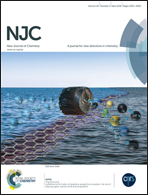Design, synthesis, linear and nonlinear photophysical properties of novel pyrimidine-based imidazole derivatives†
Abstract
Novel donor–π–acceptor (D–π–A) and donor–π–acceptor–π–donor (D–π–A–π–D) type pyrimidine imidazole derivatives with flexible ether chains (L1 and L2) have been efficiently synthesized through improved Knoevenagel condensation and Ullmann reactions with high yields. Based on systematic photophysical investigations and theoretical calculations, the structure–property relationships can be described as follows: (1) the linear and nonlinear optical properties of the target chromophores change regularly with increasing the number of branches and the polarity of the solvents. (2) The single-substituted chromophore L2 exhibited a remarkable negative solvato-kinetic effect, while the double-substituted chromophore L1 showed a positive solvato-kinetic effect. Significant bathochromic shifting of the emission spectra and larger Stokes shifts were observed in polar solvents. (3) The two-photon absorption (TPA) cross-section results further demonstrated that their TPA cross section values (δ) increase notably with increasing branch number, and the presence of high π-delocalization could induce large size-scalable TPA enhancements. (4) By comprehensively considering the optical performance, cytotoxicity and solubility, L1 was identified as the better candidate for living cell (HepG2) imaging.


 Please wait while we load your content...
Please wait while we load your content...